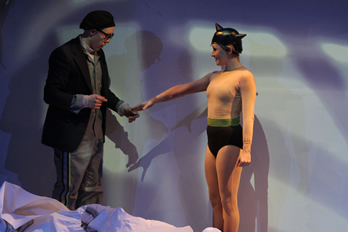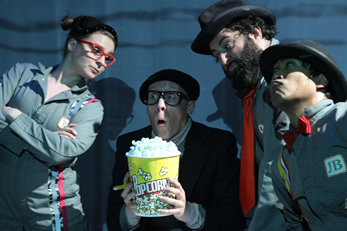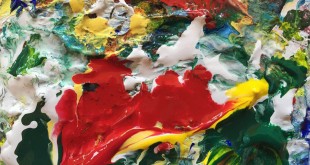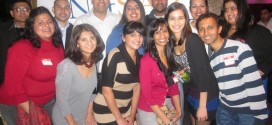Director, Writer and Illustrator Natsu Onada Power Gives D.C. Theater a New Look
By Stan Kang

The buzz about Natsu Onada Power is overwhelming. A uniquely creative “theater maker,” as she describes it, the petite Japanese American is rapidly building a following which seems destined to propel her into the top ranks of directors, writers and illustrators.
Washington Post theater critic Peter Marks rated her show Astro Boy and the God of Comics at D.C.’s Studio Theatre, the #2 show in his Top Ten of 2012. Her latest production, the startlingly innovative A Trip to the Moon, opened at Arlington’s Synetic Theatre in December to rave reviews. Oh, and her students at Georgetown University, where she teaches theater, seem to like her, too.
Here’s how Marks described Astro Boy and the God of Comics: “A feat of exhilarating imagineering, the performance piece heralded the emergence of director/writer/technical whiz Natsu Onoda Power as a captivating force in Washington theater. Almost as much ingenuity was apparent in this 70-minute exploration of the work and life of “Astro Boy’s” visionary animator Osamu Tezuka as is displayed in the design of a Mars rover. Having actors sketch onstage, as others interacted with animated movies and 3-D cartoon figures, transformed the theater from a Studio in name only to one where experimental breakthroughs truly can happen.”

And critics love A Trip to the Moon, which closes January 6. It’s a whimsical, original piece combining segments based on the 1902 silent film of the same name by Georges Méliès in which astronauts are shot to the moon by a cannon, a Japanese folk tale about a princess who longs to return to her home on the moon, and Soviet space dogs. Robert Michael Oliver wrote in MD Theatre Guide:
“…the eccentric passion of this theatre artist [Onoda Power] and her vision of a world that’s lost its moon could not have shined more robustly” and “…there were moments of visual hilarity and splendor throughout.” Tim Treanor wrote in In DC Theatre Scene: “… live actors interacting with an animated background which is at once cartoonish and so realistic and so well coordinated with the actors that it seems alive, too” and he cited “…imagination, innovation, craft, creativity…”
Her next original work, as yet unnamed, will debut in July 2013 at D.C.’s Forum Theatre.
Sitting in the lobby of the Davis Center at Georgetown University where Natsu Onada Power is an assistant professor, she discussed her creative process, her philosophy of education, and her plans as a self described “theater maker” with Asian Fortune.
AF: Tell me a little bit about your background, where you grew up, and your education
NOP: I was born in Mie Prefecture, Japan. It’s far from Tokyo. It’s in the middle of nowhere. So I grew up in a small town. I came here when I was in high school as an exchange student, and I went back to Japan to finish high school. When it was time to apply for colleges, Japanese and American universities, I knew I wanted to major in theater. But the model of theater in Japan is very different. It is not so much an academic discipline… It is like a trade or apprentice model. You go to work in a theater. I still wanted to go to college, so I decided to go to Northwestern in Illinois, sight unseen. A catalogue that I had said it was great for theater, so I picked that one. Right after undergraduate, I did the scenic painting program at Yale at the drama school.
AF: What does that mean, scenic painting?
NOP: It is like painting scenery for theater. Designers design sets and you paint it. It was an internship program in various areas of technical design, and I picked painting. There was sound design, props, and things like that, and I wanted to do scenic painting. I was also majoring in visual art in college. I was a print-making major and I liked painting and I thought ‘oh, you know, I could probably get a job in painting, pay my bills, combining painting skills and interest in theater.’
AF: And after that?
NOP: It wasn’t so interesting for me. I loved the doing of it. While I was at Yale, I directed at Yale Cabaret. Anyone can apply to direct. It was a devised piece. It was based on Japanese Ghost Stories. I really enjoyed it. I had been in devised theater pieces as a student in college. I had professors that worked on adaptations in college but I hadn’t really done my own. I decided I wanted to get a PHD in performance studies At Northwestern.
AF: What do you mean by ‘devised theater piece?’
NOP: You know that is not my term. People use that term.
AF: How would you define it?
NOP: I actually don’t like that term but I use it because people understand it. It is a kind of theater where you start not with a script, but with a loose idea or collection of ideas. The play is built as the director, ensemble and designers work on it.
AF: So what would you call it if you could rename it?
NOP: I just call it adaptation. It is really the only way that I’ve ever worked. I don’t know how I would call it.
AF: Can you describe your process then? You have directed/adapted several works that have received critical acclaim and I am curious how the adaptation or devised theater process actually works.
NOP: I think people do it in many different ways. I don’t really have a concrete process that I apply for every show. It’s kind of like I invent a process for each project. For instance when I did an adaption of Madness and Civilization by Michel Foucault for the stage, it is about the history of mental illness. I had a brother in law, who was in a mental group home. So the premise was to adapt Madness and Civilization, which is this super dense scholarly book for the stage in a way that my brother in law could enjoy. So, all the decisions in the play and production were based on what would Jim like?
There is option A and option B, and which one would Jim like? So, I built the show that way. I brought the cast to the group home to do a workshop and we got to know the residents and got to know Jim. I thought the only way he could sustain his attention for over an hour was if he was being represented on stage and if his face was projected all over the stage. There had to be singing and dancing and pretty ladies. So that was the process for that one particular show, right? For this most recent piece, A Trip to the Moon, because I was working with a company that had it’s own style already, and the actors came already trained in a very specific mode of making theater, I would work differently, and I didn’t know them at all.
AF: So you didn’t use anyone in the Synetic theater production that you had worked with before?
NOP: I had worked with one, Karen O’Connell, who was my Astro Boy for the Studio production of Astro Boy. So I asked her to audition for the Synetic company auditions. In order to be in my show, she had to go through the company auditions and company training. I kind of reunited with her during rehearsals. I really enjoyed working with her. She is a great actress. She has that kind of innocence I really love. I didn’t know any of them, except for Karen. So, the first week, I didn’t tell them who was playing who. I just ran workshops, rehearsals. I taught them how to draw. Then I asked them to come up with little performance pieces and I also observed their warm-up exercises. They do extensive physical warm up exercises. In doing so, I would make decisions: this person would be good for this role. So much of the content of the show comes from the ensemble.
AF: Did you work in the same way at Studio, with a loose outline?
NOP: I say loose outline, but I do have a pretty solid outline. It is just not revealed to them. It is revealed to stage managers and the designers, but not to the ensemble. You want their input, but I don’t want anyone to get too attached to a certain content. I do change things. I delete things, and I don’t want them to feel like, ‘Oh my line has been cut.’ So I just don’t give it to them in first place, so they don’t know that their lines are cut. At Studio, I asked for an extra week of drawing practice. My shows usually have live drawing elements, which I will probably always do.
AF: Where did that come from?
NOP: I was an art major. You know, I don’t remember when I first started doing it, but I had a performance assignment, and I am very shy. I had to take acting classes and performance classes and I didn’t want to speak at all. I was an art major and I thought I will just draw. It seems to engage people. I love watching people draw, especially when it is very skilled. It’s really not about drawing when you do it on stage. It is not about the output. It is about the process. You can sell it. It is about how you move your hand, how you move in space. Because Synetic actors are dancers, it is so easy to train them even in drawing. You give them an adjustment, and they just adjust. With actors sometimes, it can be a little bit difficult because it is a skill that they are not used to displaying, and they get very insecure.
AF: The first time you did this was in undergraduate?
NOP: You know, I don’t know for sure. I think the first time I taught it, I did a very early version of Astro Boy, which was about half of what was the current show, maybe 10 or12 years ago. My friends and I made a group called Live Action Cartoonists. One of the friends was a cartoonist, a very, very accomplished cartoonist. I thought that it would be a show about a cartoonist, I have a cartoonist on board, so why not draw? He couldn’t be the only person drawing so we trained the rest.
AF: And this has become part of your aesthetic.
NOP: Yeah. You know I have done this so long, I have developed this process that is just too bad to discard. It can just go further, further, further. For A Trip to the Moon, it was the first time I incorporated ink painting, Japanese and Chinese ink painting. I had never done that and I think in the show it works beautifully. And there is so much more I can do with this painting/drawing idea. It interacts with projections and the paper that I buy for it. It comes in these huge rolls, and I have developed a method of taping two sheets together to create an even larger sheet and putting it up and taping it up.
It sounds like a really stupid thing to do, but there is a method to it. And the first day of rehearsal, I always train the cast in paper duty. Paper duty is the process of putting the paper up. It takes a skill. Then, you develop a vocabulary by doing that. It is about completing a task that requires concentration. It is not about acting, and I have never taken a single directing class in my life, and I don’t think I am good at directing actors. But I can teach them to paint better. I am better at using people to accomplish a task.
AF: If you are not good at directing actors, what do you do when you lead a project?
NOP: I fake it. The better word is that I am not a great acting coach. I am not a good actor. I can’t tell good acting. So, I construct my show around non-acting tasks.
AF: Tell about your next project, which will be at Forum Theater.
NOP: It is a reworking of a piece that I did in 2008 at Georgetown. The piece came out of my Gender and Performance class. At the time, the piece was called The T Party, T with a capital T. And now there is this tea party and I can’t use the same title. It was about gender transgression, locally grown stories of gender transgression. We conducted interviews with the local transgender community with the student population. It is a fun piece. There is a lot more talking. I wrote more for that show but I think that is a better fit for the actors that they have. They have more classically trained actors as opposed to dancers. That’s all I can tell you. There is a scientific text about homosexuality in dolphins written by my colleague that is adapted as a dance party. There is a scene that is Instant Messaging texts and people speak them verbatim.
AF: Where does your creativity come from?
NOP: I don’t know. I am surrounded my really fascinating people, especially students. They come from all over and they are really fascinating people and it’s just too bad not to use them. I think I am a very good problem solver. I don’t think of myself as creative. If I try to be creative, that is the end of everything. It is not about me. The most important people in the room are the audience. Like, you know, I want to entertain them. I want to engage them.
AF: Let me ask you couple of questions about your education philosophy. From your aesthetic as a director, adapter, set designer, it sounds like you are very interdisciplinary and collaborative. What is your teaching philosophy?
NOP: Wow. That’s a big question. Well, first of all there are two kinds of courses, right. In classroom, there are two kinds of courses. One is that I have this set of knowledge and skills, so let me share that with you. And second kind is I have this topic that I am interested in, so let’s explore it together. I teach both of these kinds of courses like the first one, my adaptation. Gender in Performance, I have done some research, I have this great material, so can explore together. That kind of class tends to be more rewarding to me.
AF: Why?
NOP: I think because I learn so much from it. I am expecting to learn. I feel like when I go in with a mindset of teaching, sometimes it gets frustrating. So when I go in with a mindset of exploring, let’s just explore with this group of students, let’s try to learn as much as possible together with the students, then I feel more alive and we collectively end up learning so much more.
AF: You are much more collaborative in your teaching style, too.
NOP: Right, but I am not a pushover. My assignments are hard. I have to give grades. I adhere to certain standards and if they haven’t done the reading I get mad. But, yeah, that is true.
AF: Thanks for your time and for talking with our Asian Fortune readers.
For information and tickets for “A Trip to the Moon,” visit www.synetictheater.org.
 Asian Fortune Your source for all things Asian American
Asian Fortune Your source for all things Asian American



